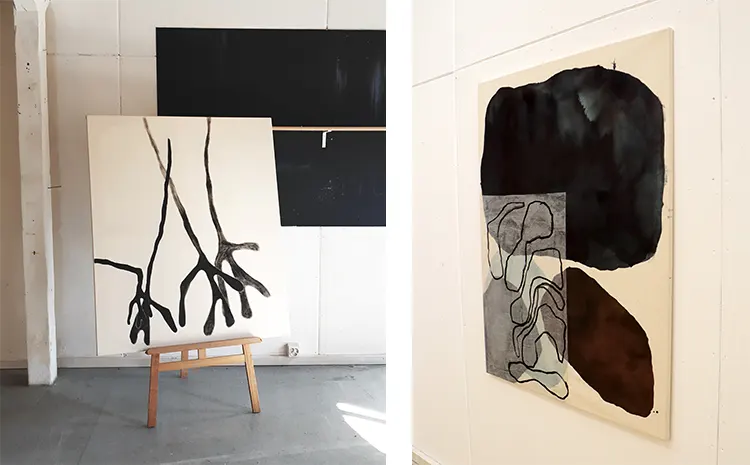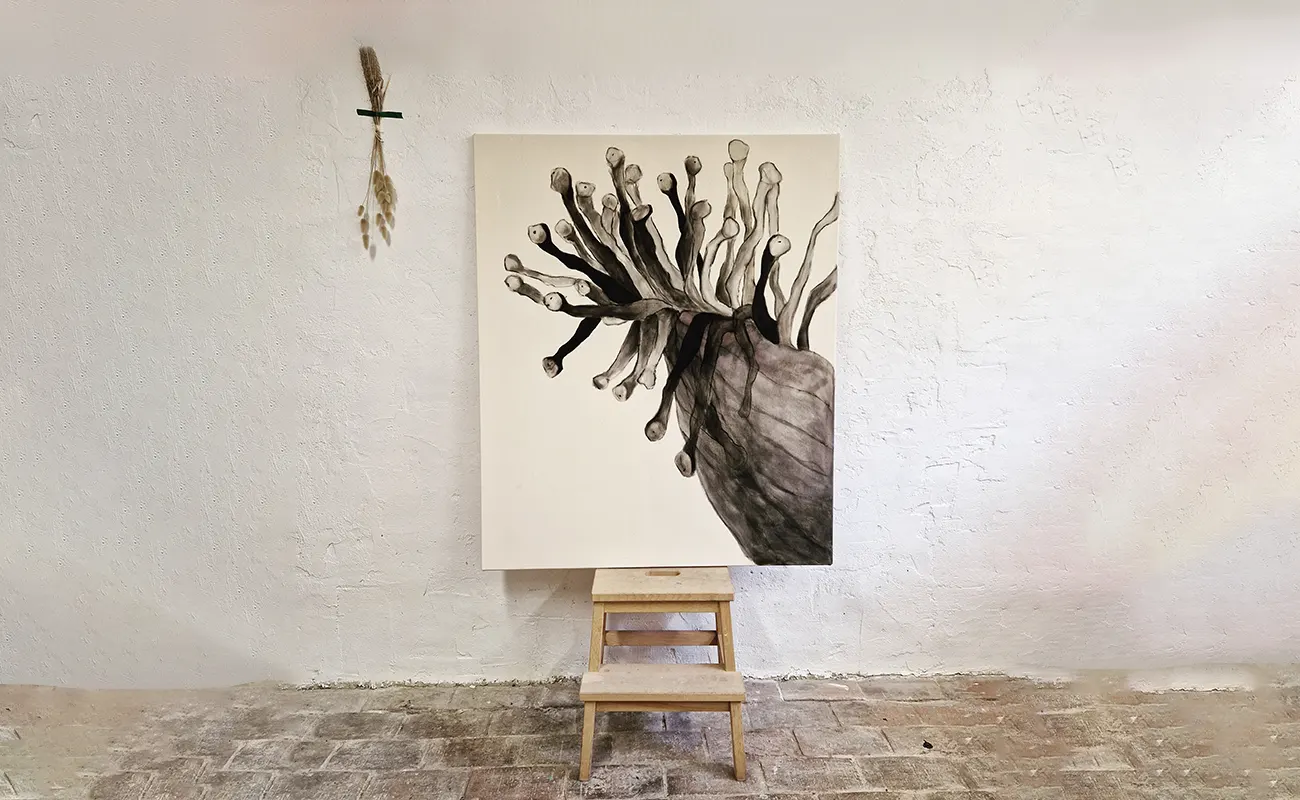“After a shattering event 9 years ago, it was clear to me that it isn’t a good plan to put off your dreams.”
A Contemporary Purveyor of Purity and Minimalism
Natacha Di Nucci, hailing from the Swiss city of Basel where she was born in 1973, discovered her artistic leanings at an early age. The routine of her childhood was dappled with moments of creative exploration, a testament to the burgeoning artistic spirit. Despite her early passion for the arts, she initially pursued a traditional commercial apprenticeship after her unsuccessful attempt at gaining entrance to an art school. This setback dampened her confidence, resulting in her venture into the more conventional realms of work.
In her professional journey, Di Nucci found herself navigating the world of office work. Although satisfactory, the experience always felt incomplete, compelling her to search for what seemed to be missing. This led her to additional studies in web design, and later in coaching, in the pursuit of that elusive element. Rather than steering her career with a distinct plan, she let opportunities shape her path, ultimately finding herself immersed in the domain of marketing for several years.
All through these years, Di Nucci continued to nurture her artistic passion, turning to painting as a beloved hobby and even attending painting classes. At the age of 36, she envisioned dedicating her life to art upon retirement. However, an impactful event five years later forced a reevaluation of her life plans, underlining the futility of postponing her dreams. This prompted Di Nucci to resume her formal study of fine arts in 2016, years ahead of her anticipated retirement.
The aforementioned life-altering event ushered in the realization of the minimal requirements for contentment, offering a new perspective on life. It led to her understanding that an excess of anything can blur the focus on what’s truly essential. This philosophy of reduction became an integral part of her life, permeating her personal sphere as well as her art.
Di Nucci’s artistry consistently pushes her to peel back layers to unearth hidden depths, echoing her relentless quest for reduction. She constantly grapples with questions about the essence of her work: how to distil it to its purest form, when to stop subtracting, and how to discern when something is still too much. It’s a perpetual process of balancing, experimenting, exploring, and letting go.
This journey of creation, for Di Nucci, is intrinsically tied to a search for inner harmony and mindfulness. The creation of her subtle and intricate works is not just a personal endeavour, but an emotional journey she hopes to share with her surroundings. She strives to make her art an extension of herself, an intimate exploration that offers insights into her worldview and her emotional landscape.
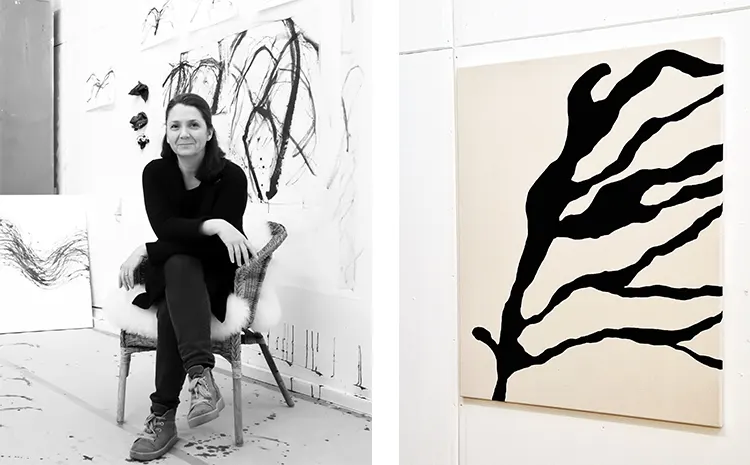
Traces: Unveiling the Invisible Connections in Natacha Di Nucci’s Art
Natacha Di Nucci is best encapsulated as a contemporary purveyor of purity and minimalism, with her creative inspirations deeply rooted in the natural world. Di Nucci’s art is a visual manifestation of her belief in the inherent simplicity of nature, portraying its elegance through her distinctively understated style.
Resourcefulness is a salient aspect of Di Nucci’s artistry. Committed to ecological sustainability, she embraces a practice of recycling, ingeniously transforming waste paper into fresh canvases for her creations. Moreover, her dedication to maintaining an eco-friendly ethos extends to her choice of materials. Utilizing naturally derived binders and handcrafted plant-based inks, Di Nucci’s approach is a testament to her pledge to environmental responsibility.
The concept of ‘traces’ serves as a central motif throughout Di Nucci’s portfolio. These traces may present themselves in various forms – apparent or concealed, subtly altering their environment, either internally or externally. They may lie dormant, only revealing themselves under the impact of new traces, or, conversely, existing traces may recede into obscurity through the emergence of fresh ones.
A driving force behind her ‘Traces’ series is Di Nucci’s predilection for a “neutral” working surface and the use of reduced materials, with the explicit intent of leaving deliberate traces. The goal is not only to ascribe significance to an individual trace, but also to employ existing traces in the creation of new ones.
Throughout her creative process, Di Nucci grapples with intriguing queries such as the significance of a single trace, the evolving dynamics when additional traces are added, the resurgence of concealed or forgotten traces, the relegation of traces into the background, the harmony achieved when a trace integrates without disturbing the overall cohesion, and finally, how a trace can maintain its individuality whilst still being an integral part of a greater interaction. These introspective questions serve as catalysts, fueling the continued evolution of Di Nucci’s unique artistic expression.
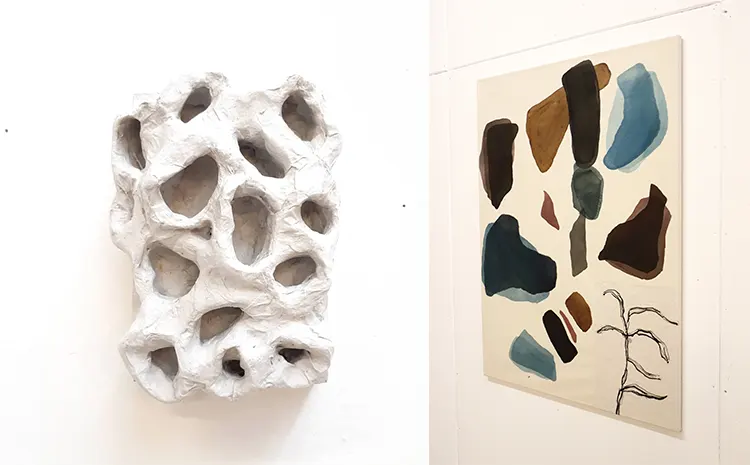
Plants: Unseen Influences and the Interconnectivity of Natacha Di Nucci ‘s Work
In her thematic subset “Plants”, Natacha endeavors to reveal the unseen elements, underlining the imperceptible yet significant influence they exert upon their surroundings. Rather than focusing solely on the overt aesthetic of the plant, Di Nucci’s work is a testament to the invisible interconnectivity of the natural world.
Di Nucci’s work can be delineated into specific series such as “Traces”, “Corals”, and “Seaweed”. These series are not isolated entities but interweave seamlessly to communicate her overarching narrative. “Traces”, as the primary series, sets the stage for the artist’s exploration of implicit and explicit remnants of human activity.
The series “Corals” further emphasizes the motif of traces, encapsulating the duality of materiality and symbolism. Di Nucci utilizes recycled materials, such as homemade paper and cardboard, to construct her pieces, tangibly linking her work to the idea of reusing and recycling. This series also metaphorically signifies the human footprint left on marine environments, prompting a contemplative reflection on ecological conservation.
On the other hand, the “Seaweed” series celebrates the bewitching allure and vulnerability of underwater ecosystems. This series serves as a homage to the enigmatic beauty of marine life, embodying Di Nucci’s fascination with the aquatic realm.
In her formative years, Di Nucci primarily used acrylic paints, drawing inspiration from various esteemed artists. Nevertheless, it was nature that emerged as the paramount influencer of her artistic journey. As her appreciation for natural elements amplified, she transitioned towards utilizing organic painting materials. Di Nucci’s current methodology includes the use of self-made ink, gouache, earth pigments, and watercolor, exclusively utilizing natural substances even for priming canvases.
Currently, Di Nucci finds herself in a stage of creative drift, willingly succumbing to the natural ebbs and flows of artistic exploration. Though the trajectory of her forthcoming work remains undisclosed, the artist’s process is actively percolating, shaping itself in the depths of her creative psyche. The anticipation of what lies ahead serves to amplify the intrigue surrounding Di Nucci’s ever-evolving artistic journey.
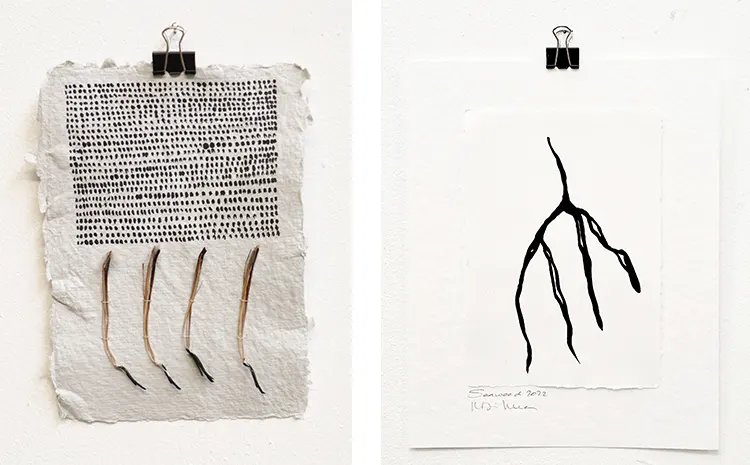
The Creative Process: Nurturing Inner Harmony and Shaping Natacha Di Nucci’s Artistic Universe
Natacha Di Nucci’s creative process necessitates a profound connection with her inner self and intuition, alongside the indispensable elements of space and time. She recognizes the restrictions of excessive rationality, referring to such periods as being overly ‘in the head’. These instances signal the need for Di Nucci to immerse herself in the nurturing embrace of nature. Her strategies for reconnection encompass sketching the outdoors with a fineliner in a sketchbook or indulging in the grounding practice of gardening. These seemingly distinct endeavors are inextricably intertwined, feeding into her artistic universe and shaping the essence of her works.
The process is not confined to the act of painting for Di Nucci; rather, it encompasses the phases preceding and succeeding the creation. Therefore, when she is engaged in gardening, she is indirectly nurturing the conceptual underpinnings of her paintings. The notion of labour extends beyond the canvas, suggesting that the garden also becomes an extended studio, a space for contemplation and creation.
One particular artwork that has deeply influenced Di Nucci is Hilma af Klint’s ‘The Ten Largest.’ Its impact is heightened when considering the timeframe of its creation between 1906 and 1915, a period that attests to Klint’s groundbreaking exploration of abstraction even before the celebrated Kandinsky. This historical recontextualization serves as a remarkable revelation for Di Nucci. Klint’s attempts at public display of her works during her lifetime met with less than enthusiastic response, leading her to determine that her pieces would only re-emerge for public consumption twenty years posthumously. She held faith in the possibility that future societies would demonstrate a more mature receptivity to her artistic language, an insight that resonates with Di Nucci.
